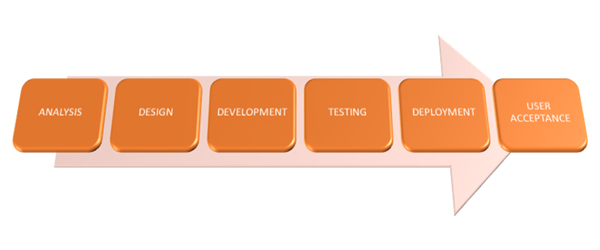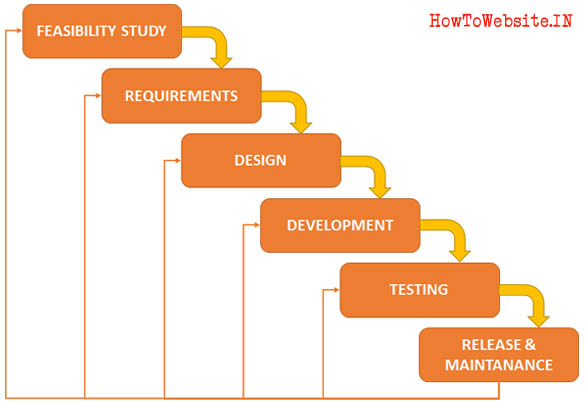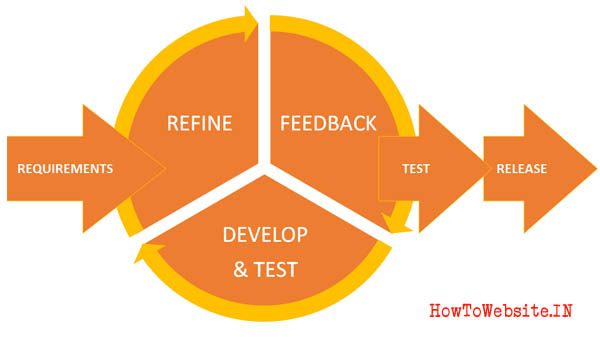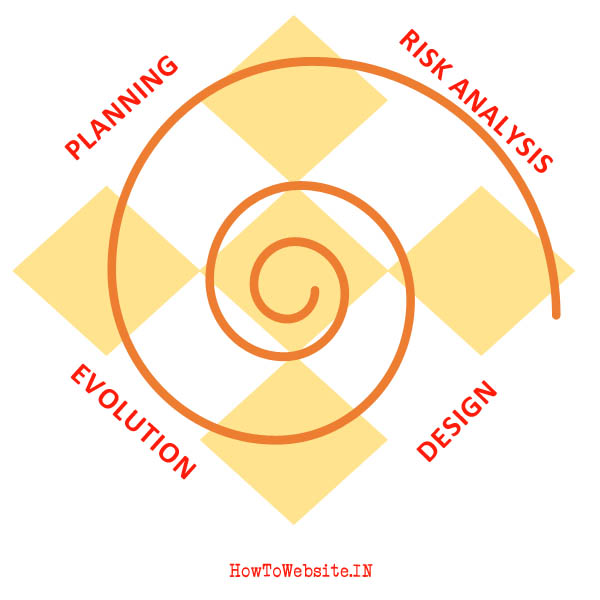The Most Common must know Software Development life cycle Models

As we discussed in our earlier article on Software Engineering, we have learned about the aspects of Software Engineering and the qualities that it should possess. Now let us move ahead and learn about the models of the software development life cycle.
What is a software development life cycle?
A software development life cycle, sometimes also called the SDLC life cycle, represents and describes the various activities that are to be performed to build a software product. These activities are grouped into several phases and sequentially linked in order. Hence we can also say, that a software development life cycle is a structured list of activities that are followed to develop software, from the inception to the delivery of the final product.
During any phase of the life cycle of development, one or more activities might have to be carried out to start or finish that phase. For example, in the inception phase of actual coding, it is expected that the architectural designing phase is completed.
Why software development life cycle model is required?
In every model of SDLC, every phase may have its own child life cycle, for every team of a specific skill set. So in an environment of complicated projects and a variety of skill-based teams, it is vital to follow a pre-defined structured process. This creates discipline and maintains decorum in the working culture. All team members are interdependent. Failure of any one team will affect the deliverables of other teams. And all together it might lead to project failures.
SDLC also defines entry and exit criteria for every phase. For example, say, if a team member starts coding, assuming that pro-activeness will help finish the project much earlier. This would be the perfect recipe for disaster and project failure.
Why? Because, after putting down a month of effort they might realize that the project needs a roving vehicle on Mars to collect data. Unfortunately, the team doesn’t have that with them. So they can not proceed further.
That means a feasibility study was not performed before the team started working on deliverables. Which in technical terms, is a breach of SDLC, and hence the loss of effort, or project failure.
The team should have done a feasibility study before jumping straight into deliverables. Then they would have realized that the project is not doable, many days in advance. As so, they could have saved some unnecessary effort.
Hence it is strongly suggested to follow a methodology, or process while working on complex and team-based projects. It becomes easier for the entire team to work together, support each other, manage, and track the progress of the development. Regardless of the model you follow, SDLC models always ensure smooth delivery, reporting, and chaos-free delivery of the project.
Common Software Development Life Cycle (SDLC) Models
Waterfall Model

The classic SDLC waterfall model is a process of software development that is widely used by software engineers. It provides a structured approach to managing the software development process and is one of the most commonly-used processes in software development.
The waterfall model involves a series of sequential steps. The steps include requirement gathering and analysis, design, coding, testing, and maintenance. The process begins with gathering requirements, which requires understanding the customer’s needs and then designing the system to meet those needs. Once the design is complete, the coding and testing stages begin. During testing, the software is checked for errors, and the code is adjusted to ensure that it meets the customer’s requirements. Finally, once the software is ready to be released, it is placed in maintenance mode, where any necessary updates or bug fixes can be made.
The waterfall model is an effective method for software development, as it allows software engineers to systematically develop and test applications. It also provides a clear view of the progress of the development, allowing engineers to easily identify areas that can be improved. Additionally, the waterfall model is best suited for projects with a well-defined scope, as it does not easily allow for changes in scope.
Prototyping Model

The prototyping model of the software development life cycle model helps to develop software applications quickly and cost-effectively. It is an iterative process that helps in providing a framework to design, develop, and test the application. The prototyping model is used when there are requirements that are not well understood or are difficult to implement. It helps in developing a prototype of the software quickly and testing it with the users. This helps in receiving faster feedback from the users and making the required changes early.
The process is divided into four stages: requirement analysis, design, implementation, and testing. In the requirement analysis stage, the requirements for the software are gathered and documented. This stage helps in understanding the user requirements and needs. In the design stage, a prototype is created that can be tested and used. In the implementation stage, the code is written according to the design. Finally, the prototype is tested and any bugs or issues are fixed.
The prototyping model helps in reducing risks associated with developing complex software applications. It also helps to reduce development time and costs and enables quick feedback from users. It ensures that the software meets the requirements and is within the planned timelines. Overall, the prototyping model is an effective approach to developing software applications faster and cost-effectively.
Iterative Waterfall Model

The iterative waterfall model is a software development methodology that is similar to our classic waterfall method, with some advanced features. This model utilizes a series of well-defined steps to move from concept to completion. This model is a great choice for projects that require a high degree of accuracy and control, as the process is well-defined and repeatable.
Unlike other models, the iterative waterfall model starts with the feasibility study and then moved to the requirement gathering. During this phase, the requirements of the project are collected and analyzed. This is followed by the design stage, where the system architecture is planned and designed. Once the design is complete, it enters into the development stage, where the actual coding and coding standards are set.
Next, the testing stage begins. This is where the newly developed product is tested for bugs and any errors that may be present. Once the testing is complete, the product is ready for release. However, the process does not end here. After the product is released, the feedback from users is collected and analyzed. This helps to identify any further refinements that need to be made prior to the next release.
This model is great for projects that require a high degree of accuracy and control. It provides a systematic approach that allows for multiple iterations and refinement. Additionally, it is cost-effective and allows for a high degree of customization and scalability.
Rapid Action Development

Rapid Action Development (RAD) is a software development life cycle methodology that promotes a fast pace development of high-quality products by using iterative prototyping, user feedback, and rapid development cycles. This agile methodology is used to quickly create operational systems and applications that are designed to meet changing user needs.
RAD uses rapid prototyping to ensure that the development process is focused on the quickest delivery of the required product, rather than spending unnecessary amounts of time on design and planning. It emphasizes customer satisfaction and early user feedback to ensure that the product meets the customer’s needs and expectations. This is done by creating prototypes or mockups of the product, which can be tested and iterated upon as needed.
In addition to its emphasis on rapid development, RAD also focuses on the reuse of existing code and components. By reusing components, developers are able to quickly and easily create new products without having to start from scratch. This is especially useful for large projects that require complex modules and features.
Overall, this is a great way to quickly develop high-quality products that meet user expectations. It is ideal for projects that require quick turnaround times, such as web-based applications, mobile apps, and other time-sensitive projects.
Spiral Model

The spiral model of the software development life cycle is a development process that combines iterative and incremental processes into one. It is a type of model that is used for creating complex systems that are difficult to define, build, and test. In the spiral model, the entire development process is broken down into smaller, more manageable units. Each iteration of the spiral includes a risk assessment of the project, which helps to identify any potential issues before they become more costly or difficult to fix.
The spiral model is composed of four different phases: Planning, Risk Analysis, Development, and Evaluation. Just like other models, in the planning phase, the project’s requirements are identified and the development process is mapped out. The risk analysis phase is used to identify any risks or challenges that may arise during the course of development. During the development phase, the actual programming and development of the software take place. The evaluation phase is used to review the software and make sure that it meets the requirements that were set during the planning phase.
The spiral model is a great choice for software projects that require a lot of risk management and iteration. It offers the ability to review and refine the project as it progresses, while also allowing for changes to be made as needed. This model is also well-suited for complex software systems that may require a high level of customization. The SDLC spiral model is an ideal choice for software development projects that require flexibility and risk management.
Download Software Development Life Cycle (SDLC) PDF.
Read more about Software Engineering.
Suggested Reads
- Learn Binary Numbers in a simple and easy way.
- A simple and amazing Magic Trick using Binary Numbers.
- Learn Hexadecimal Numbers: The simple and easy way.
- Learn to create Flowcharts that are Easy to Understand and Follow.
- Loops in Programming: In the simplest and easy terms.
- Software Engineering in a quick and easy way.
- The Most Common must know Software Development life cycle Models
- An Adventure into Object Oriented Programming
- Encapsulation: The Heartbeat of Object Oriented Programming
- Data Dictionary in Software Engineering
- Harness The OOP's Power Of Diversity with Polymorphism
- Build powerful and meaningful relationships in OOP using Inheritance
- Abstraction - Illuminating the Nexus of Simplified and Profound Concepts
- Demystifying Statistical Testing in Software Engineering
- Software Requirement Specification - The Vital Blueprint
- Elevate Your Code: Coding Standards in Software Engineering
- Design Patterns for Unparalleled Excellence
- Requirement Analysis and Specification: The Essence of Empowering
- Harnessing the Essence of Classes and Objects
- Adapter Pattern
- The Symphony of Composition and Aggregation for Engineering Excellence
- Bridge Pattern
- Composite Pattern
- Decorator Pattern
- Elevate Your Software: The Ultimate Guide to Strategic Project Planning
- Software Design - Your Gateway to Software Engineering
